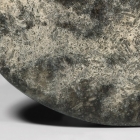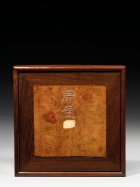J.J. Lally & Co., Oriental Art / New York City, New York
Menu2.
A NEOLITHIC DARK GREEN JADE BI DISC
Liangzhu Culture, circa 3300 – 2250 B.C.
with thick flat sides and rounded outer edge, polished to a smooth lustrous surface all over, the small central aperture drilled from both sides with a narrow ledge remaining in the middle, the very dark green, almost black jade with pale cloudy mottling on one side and continuing unevenly over the outer edge; Chinese fitted box with brocade lining and inset burl wood panel bearing the carved inscription: Zhou bi (周璧).
Diameter 5 inches (12.8 cm)
Provenance
From the Collection of Eugene Meyer (1875-1959) and
Agnes E. Meyer (1887-1970)
This type of bi disc, with thick sides and small central aperture, is a characteristic Liangzhu Culture jade form. Comparable examples in various sizes have been excavated at many Liangzhu Culture burial sites. Several similar bi discs discovered at the Liangzhu site in Fanshan, near Hangzhou, Zhejiang province are illustrated in line drawings and cross-sectional views in the excavation report published in Wenwu, 1988, No. 1, p. 10.
Compare also the Liangzhu bi disc of slightly larger size unearthed from the Xin’anqiao site, Deqing, Zhejiang province, now in the Deqing Museum, illustrated by Gu (ed.), Zhongguo chutu yuqi quanji (Complete Collection of Jades Unearthed in China), Vol. 8, Zhejiang, Beijing, 2005, p. 39.
A similar Neolithic jade bi disc of slightly smaller size in the Luoyang Museum is illustrated by Gu (ed.), Zhongguo chuanshi yuqi quanji (Chinese Jades in Traditional Collections), Vol. 1, Neolithic Period, Shang, Western Zhou, Spring and Autumn Period, Warring States Period, Beijing, 2010, p. 59. Another jade bi disc of smaller size is illustrated by Loehr, Ancient Chinese Jades from the Grenville L. Winthrop Collection in the Fogg Art Museum, Harvard University, Cambridge, 1975, p. 37, no. 7.
新石器時代 良渚玉璧 徑 12.8 厘米
出處 邁爾夫婦舊藏

